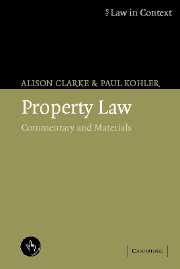Book contents
- Frontmatter
- Contents
- Preface
- Acknowledgments
- Table of cases
- Table of statutes
- Table of statutory instruments
- Table of treaties
- Table of EC legislation
- Part 1 The concept of property
- Part 2 The nature of proprietary interests
- Part 3 The acquisition and disposition of property interests
- Part 4 Proprietary relationships
- 16 Co-ownership
- 17 Leases and bailment
- 18 Security interests
- Bibliography
- Index
17 - Leases and bailment
Published online by Cambridge University Press: 05 June 2012
- Frontmatter
- Contents
- Preface
- Acknowledgments
- Table of cases
- Table of statutes
- Table of statutory instruments
- Table of treaties
- Table of EC legislation
- Part 1 The concept of property
- Part 2 The nature of proprietary interests
- Part 3 The acquisition and disposition of property interests
- Part 4 Proprietary relationships
- 16 Co-ownership
- 17 Leases and bailment
- 18 Security interests
- Bibliography
- Index
Summary
Introduction
As we saw in Chapter 7, the essential similarity between leases and bailments is that, in both cases, possession becomes vested in a non-owner for a limited period. If the thing in question is land, the interest created is a lease, and if it is a chattel the interest created is a bailment. However, as we see in this chapter, the differences between leases and bailments are much greater than the similarities. Although the common law originally considered each to be part of the law of personal property, they have very different historical roots and have developed along separate lines so that, even now, there is almost no resemblance between the two legal institutions. This causes some difficulty in our legal system. A lease of land is a sophisticated but somewhat inflexible institution, not easily adjustable to meet changing social and commercial expectations (see, for example, Prudential Assurance v. London Residuary Body [1992] 2 AC 386, discussed below), and this can limit its usefulness. On the other hand, it is a clearly defined property interest which is relatively easy to protect and enforce against third parties, and it would be very useful if a similar interest could be created in goods, particularly commercially tradable ones like aircraft, works of art or computer equipment. However, although bailments of such goods are often called leases, they remain in law bailments, and it is very doubtful whether even the most careful drafting can give a bailee of goods the same rights and protection as a lessee of land.
- Type
- Chapter
- Information
- Property LawCommentary and Materials, pp. 609 - 656Publisher: Cambridge University PressPrint publication year: 2005



